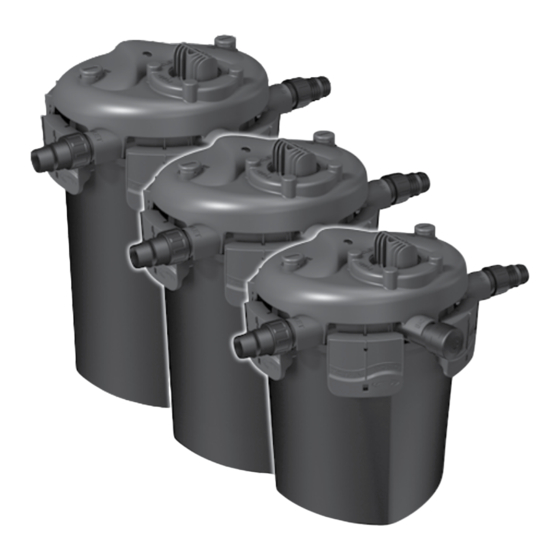
Tabla de contenido
Publicidad
Idiomas disponibles
Idiomas disponibles
Enlaces rápidos
Bio-Active Pressure Filter
BP1500 BP2500 BP4000
BEFORE YOU START
Please visit
Before operating this product for the first time, please read the safety warnings contained within this instruction guide.
RECOMMENDED PUMPS
Tetra
Pond DHP3600
®
Tetra
Pond DHP4200
®
Do not use with pumps that exceed 5,000 gallons per hour. This could
damage the filter.
Do not use pumps with flows less than 2,500 gal/hr. A minimum of 2,500
gallons per hour is necessary to perform the backflush operation.
NOTE: All pressure filters restrict the flow from your pump. Expect about a
45% reduction in the water flow through the filter.
Lid Assembly
Pond water flows down through the bio-activators,
which remove suspended debris and dirt from the water.
Biological Filtration: Occurs on the massive surface areas found in the
bio-activators. Beneficial bacteria will naturally colonize on the surface
area and convert harmful pollutants in the water into relatively harmless
nitrates, which are absorbed by the aquatic plants and removed by partial
water changes. This is known as the "Nitrogen Cycle."
for time-saving tips and inspirational ideas.
SAVE THESE INSTRUCTIONS
TETRA
POND BIO-ACTIVE PRESSURE FILTER PARTS
®
Backflush
Valve
Backflush Port
Latches
Inlet Port
Strainer
Vortex
Chamber
HOW IT WORKS
The design of these bio-activators provides unrestricted water flow to all the
surfaces for improved cleaning during the backflush cycle.
The backflushing process helps remove accumulated dirt buildup so that all
surface areas remain available for biological activity.
Outlet Port
BIO-ACTIVATORS
POND SIZE
BP1500: for ponds up to 1,500 gallons
BP2500: for ponds up to 2,500 gallons
BP4000: for ponds up to 4,000 gallons
Decorative
Lid Closure
Knobs (2)
Center Tube
Bio-Activator
Chamber
(Vessel)
Bio-Activators
Water Jets
Publicidad
Tabla de contenido

Resumen de contenidos para Tetra Pond BP1500
- Página 1 Before operating this product for the first time, please read the safety warnings contained within this instruction guide. RECOMMENDED PUMPS POND SIZE Tetra Pond DHP3600 BP1500: for ponds up to 1,500 gallons ® Tetra Pond DHP4200 ®...
-
Página 2: Filtration Process
FILTRATION PROCESS Pump water from the pond to the pressure filter. Water is mechanically and biologically filtered. Filtered water is forced up the center tube. Filtered water is forced under pressure to the waterfall or stream. General Installation Instructions: • Position the pump far from the waterfall or stream for maximum pond circulation. - Página 3 Remove any debris that has accumulated on the cage. See assembly instructions for more details. Bio-Activators - Should you lose any bio-activators, there is replacement media is available. Please contact our specialists at Tetra Customer Care.
- Página 4 Changing up to 25% of the pond water is another way of reducing nutrients which contribute to algae growth. Be sure every time you do water change to use a water conditioner such as Tetra Pond AquaSafe water conditioner to neutralize chlorine and chloramines ®...
- Página 5 REMARQUE : Tous les filtres à pression restreignent le débit de votre pompe. Prévoyez une réduction d’environ 45 % du débit d’eau à travers le filtre. CONSERVEZ CES DIRECTIVES PIÈCES DU FILTRE À PRESSION BIOACTIF TETRA POND ® Soupape de Orifice de sortie...
-
Página 6: Processus De Filtration
PROCESSUS DE FILTRATION L’eau est pompée de l’étang vers le filtre à pression. L’eau est filtrée mécaniquement et biologiquement. L’eau filtrée monte dans le tube central. L’eau filtrée est acheminée par pression vers la chute d’eau ou le courant d’eau. POSITIONNEMENT DU FILTRE À... -
Página 7: Connexion De La Tubulure
Pour un débit maximal, utilisez une tubulure de 1½ po d.i. Convient aussi à une tubulure de 1¼ po d.i. Utilisez la tubulure anti-plis Tetra Pond pour de meilleurs résultats. CONSEIL : Pour un débit maximum, fixez le plus gros raccord de boyau. Utilisez une scie pour couper le raccord de sortie et d’entrée du filtre afin qu’il convienne... - Página 8 à la main ou avec le jet puissant de la buse d’un boyau. Un filet à mailles fines peut être utilisé pour enlever les algues filamenteuses une fois qu’elles ont été détachées de la pierre. Vous pouvez aussi utiliser la solution Tetra Pond ®...
-
Página 9: Filtro A Presión Bioactivo
NOTA: Todos los filtros a presión restringen el flujo desde su bomba. Prevea una reducción del flujo de agua a través del filtro de alrededor del 45%. GUARDE ESTAS INSTRUCCIONES PIEZAS DEL FILTRO A PRESIÓN BIOACTIVO TETRA POND ® Válvula de... - Página 10 PROCESO DE FILTRACIÓN Bombea agua desde el estanque al filtro a presión. El agua se filtra mecánica y biológicamente. El agua filtrada es forzada hacia arriba por el tubo central. El agua filtrada es forzada a baja presión hacia la cascada o corriente. COLOCACIÓN DEL FILTRO A PRESIÓN Instrucciones generales de instalación: •...
-
Página 11: Conexión De Los Tubos
Para obtener el flujo máximo, use un tubo con diámetro interior de 1½ pulg. También sirven los tubos con diámetro interior de 1¼ pulg. Use los tubos Tetra Pond que no se retuercen para obtener mejores resultados. CONSEJO: Para obtener el flujo máximo, conecte el conector para tubo más grande. Corte los conectores de salida y entrada del filtro con una sierra para que coincidan... -
Página 12: Cuidado En Invierno
Cambiar hasta el 25% del agua del estanque es otra manera de reducir los nutrientes que contribuyen al crecimiento de algas. Cada vez que cambie el agua, asegúrese de usar un acondicionador de agua, como Tetra Pond AquaSafe para neutralizar el cloro y las ®...










